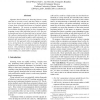Free Online Productivity Tools
i2Speak
i2Symbol
i2OCR
iTex2Img
iWeb2Print
iWeb2Shot
i2Type
iPdf2Split
iPdf2Merge
i2Bopomofo
i2Arabic
i2Style
i2Image
i2PDF
iLatex2Rtf
Sci2ools
ACSAC
2005
IEEE
2005
IEEE
Detecting Intra-enterprise Scanning Worms based on Address Resolution
Signature-based schemes for detecting Internet worms often fail on zero-day worms, and their ability to rapidly react to new threats is typically limited by the requirement of some form of human involvement to formulate updated attack signatures. We propose an anomaly-based detection technique detailing a method to detect propagation of scanning worms within individual network cells, thus protecting internal networks from infection by internal clients. Our software implementation indicates that this technique is both accurate and rapid enough to enable automatic containment and suppression of worm propagation within a network cell. Our approach relies on an aggregate anomaly score, derived from the correlation of Address Resolution Protocol (ARP) activity from individual network attached devices. Our preliminary analysis and prototype indicate that this technique can be used to rapidly detect zero-day worms within a very small number of scans.
| Added | 24 Jun 2010 |
| Updated | 24 Jun 2010 |
| Type | Conference |
| Year | 2005 |
| Where | ACSAC |
| Authors | David Whyte, Paul C. van Oorschot, Evangelos Kranakis |
Comments (0)

